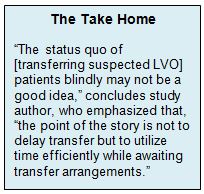Key Points:
- Small study looks at impact of pre-transfer imaging on groin puncture times in suspected large vessel occlusion strokes
- Strategy could help streamline treatment and minimize delays to endovascular intervention

John W. Liang, MD, of Thomas Jefferson University Hospital (Philadelphia, PA) and colleagues identified 57 emergency department (ED) transfers to Mount Sinai Hospital (New York, NY) for possible endovascular therapy for suspected LVO between January 2015 and March 2016. Of these patients, 39 (68%) subsequently underwent endovascular therapy. The investigators compared mean outside hospital arrival to groin puncture time (defined as the difference between groin puncture and outside hospital arrival time minus ambulance travel time) between the 22 patients who had CTA before transfer and the 17 who received it only upon arrival at the destination hospital.
There were no differences between the two groups with respect to mean age or mean National Institutes of Health Stroke Score (NIHSS). In addition, there was virtually no difference in mean outside hospital arrival to groin puncture time among those who received endovascular therapy (table 1).
Table 1. Characteristics by Timing of CTA
|
Overall |
CTA Before Transfer (n = 24) |
CTA After Transfer (n = 33) |
|
Mean Age, yrs |
74.5 |
72.4 |
|
Mean NIHSS Score |
18.8 |
20 |
|
Mean Outside Hospital Arrival to Groin Puncture Time, mins |
191 |
190 |
Findings Led to Protocol Change
“Most studies typically conclude that patients with suspected LVO should be transferred ASAP, and that was the protocol our center used for a while,” Dr. Liang told Neurovascular Exchange in an email. But when he and his colleagues noticed how many transferred patients subsequently did not require an endovascular intervention, they began to question the wisdom of this approach. Patients without an LVO could well benefit from rapid identification and treatment without the delay of an ultimately unnecessary transfer, they reasoned. “We conducted this study to see if performing the CTA before sending the patient led to any significant delays overall, and we were shocked that there was no time difference.”
Dr. Liang said these findings, “suggest to us that the status quo of sending patients blindly may not be a good idea.” In response, they have adopted a change in protocol. “After working closely with our sending facilities, we were able to streamline a process where all ‘stroke codes’ get an automatic CT head plus CTA,” he explained. “Once the radiology techs are properly trained, this extra CTA adds about 5 minute to the total imaging time, and we have an answer immediately. No guessing needed. The extra few minutes to obtain imaging is of no consequence to the overall transfer time, since it typically takes more than 5 minutes to arrange an ambulance/helicopter to transfer the patient.”
According to Dr. Liang, this protocol change has the benefits of eliminating the cost and inconvenience to family associated with unnecessary transfers, as well as mitigating hospital overcrowding.
“It should be stressed, however, that this system worked because sending facilities were open and receptive to our idea,” he cautioned. “If, for any logistical reason, a CTA could not be performed in a timely manner, we would still advocate sending the patient without delaying transfer. The point of the story is not to delay transfer, but to utilize time efficiently while awaiting transfer arrangements.”
Source:
Liang JW, Stein L, Wilson N, et al. Timing of vessel imaging for suspected large vessel occlusions does not affect groin puncture time in transfer patients with stroke. J NeuroInterv Surg. 2017;Epub ahead of print.
Disclosures:
Dr. Liang reports no relevant conflicts of interest.

